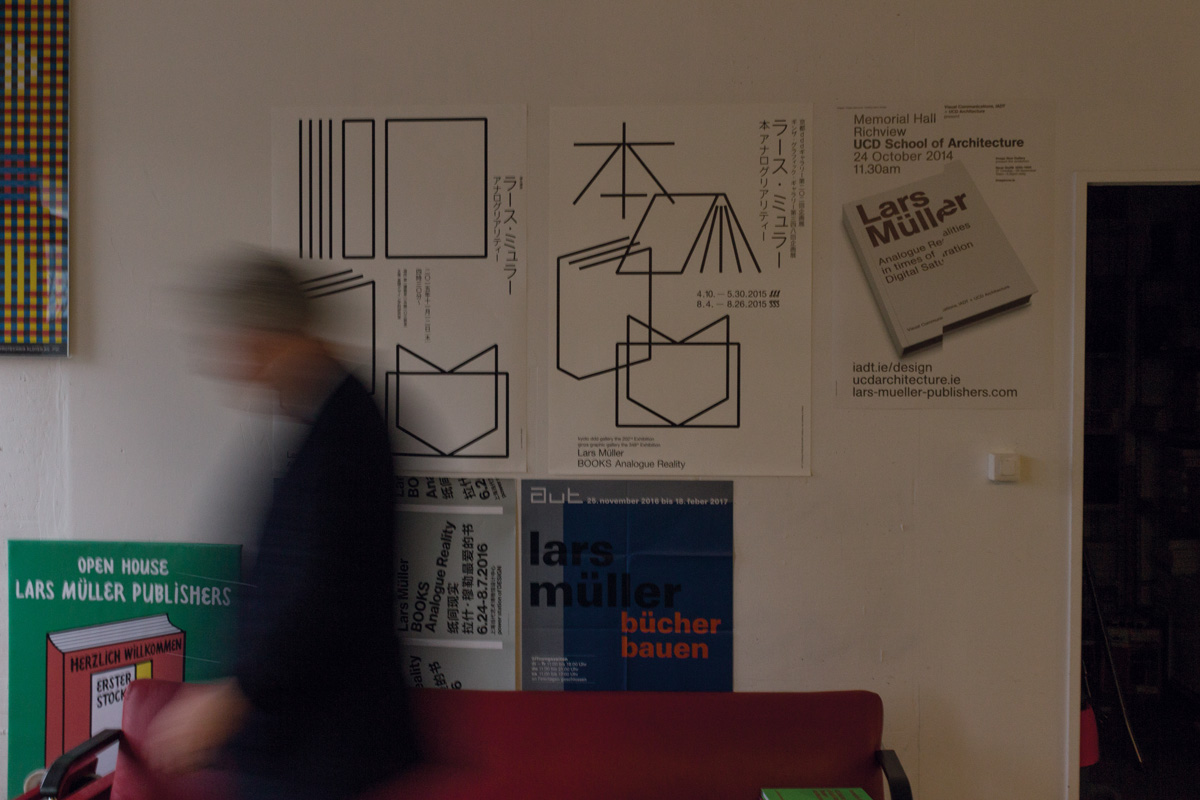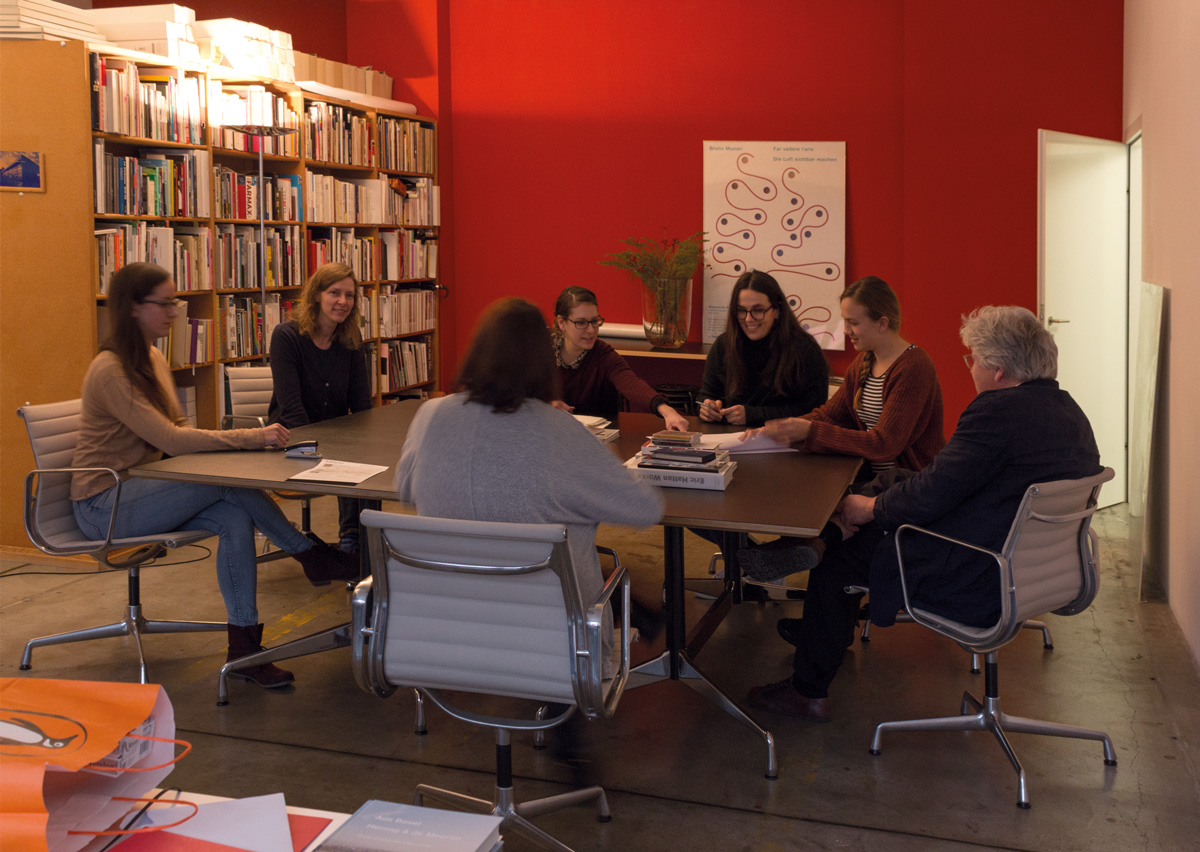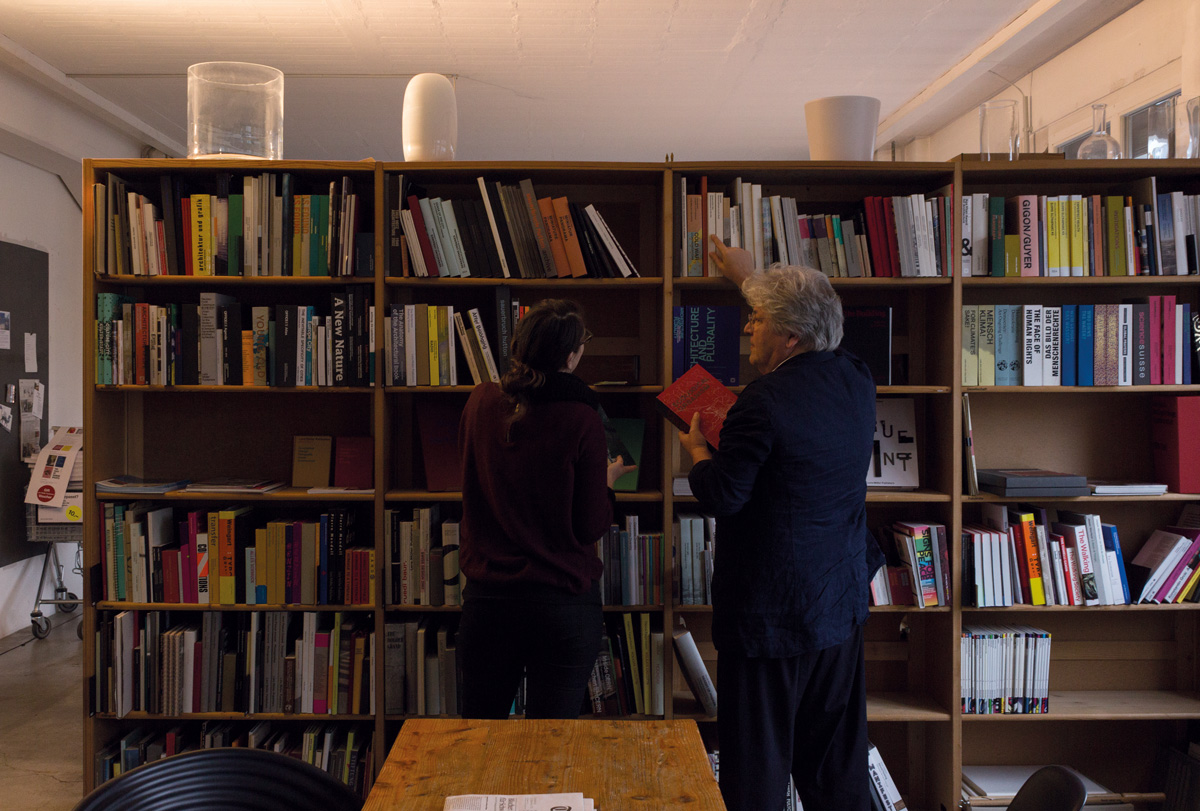LARS MÜLLER HAS BEEN DOING WHAT HE IS GOOD AT FOR MORE THAN THREE DECADES AND ANOTHER IS SURE TO COME
TEXT: KANOKWAN TRAKULYINGCHAROEN
PHOTO COURTESY OF LARS MÜLLER PUBLISHERS
(For Thai, please scroll down)
On Friday the 24th and Saturday the 25th of November, 2016, not too far from FREITAG Flagship Store in Zurich, just a few steps from the corner of Hardstrasse and Pfingstweidstrasse street, a hip roofed building stands quietly behind a tree. The bright green color sign at its entrance let the passerby know that going on inside was Lars Müller Publishers’ Open House, an event which has been held annually since the relocation of the publishing house’s office from Baden to Zurich in 2012.
The vibe at Lars Müller Open House was simple and casual, pretty much like an after-work get-together where you sit down and have a drink with friends you share common interests with as conversations about miscellaneous topics flow tirelessly. Those who arrived first found their seats at the long dining table located in the middle of the room. Some were on the sofas talking, while some browsed the shelves stacked with books published by the renowned publishing house, categorized chronologically. The demographic of the crowd that night ranged from students and the working-age crowd to children who came with parents. Everyone was granted access to check out every area of the office from the dining room, pantry, editorial staffs’ desk, marketing and production control unit to the graphic team’s department with a corner complete with background and lighting equipment for photography. Following the loop, we came across a long shelf and office of the founder and owner, Lars Müller located next to the first room we were in when we first entered the premise. Being able to see, touch and feel the books that the publishing house has created over the years all at once grants a better and closer look into the publishing house’s DNA. And while we were browsing its amazing publications, a simple question popped up…What does the DNA of Lars Müller Publishers really look like?

The ten staff, Lars Müller included, took turns greeting the visitors as Müller mentioned how the Open House day is the day he gets to know his readers, who are also able to learn more about the creator of their favorite books through simple conversations in the space where they have worked throughout those years as book after book has been created.
Lars Müller is a Norwegian who was raised in Baden, Switzerland. He once worked as an assistant for Wim Crouwel at Total Design in Amsterdam. Crouwel inspired his interest in book design, which led to the birth of his iconic work Swiss Graphic Design (1950s-60s). After a year of working with Crouwel, he came home and founded a Baden-based communication and design firm in his own name in 1982 before Lars Müller was established the following year.

Expectedly, the first few years of the publishing house had been a struggle. It wasn’t able to stay self-sufficient and relied on the financial support from Müller’s design career in order to survive. In 1989, he readjusted the structure of the operation and, while the 90s was the time when discussion in the industry revolved intensely around the death of print media, Müller reprinted a series of publications from the early 20th Century with the intention for the new edition to be as close to the originals as possible. He also wrote a book about Josef Müller-Brockmann, Switzerland’s prominent graphic designer. The decade was the period of time when the DNA of Lars Müller Publishers began to ramify to photography by Swiss artists and architecture in Switzerland. Müller wrote a letter inviting Peter Zumthor to collaborate with him for Peter Zumthor Works: Buildings and Projects, 1979-1997, the architect’s own retrospective. He decided to let Zumthor write his own stories and experiences, which was something Müller viewed as a question toward the quantity and quality of architecture retrospective publications swamping the market at the time. These publications shared the same structure—opening with an article written by recognized academics in the field and followed by a handful of works by the architect. The result that the book brought back to the publishing house was a greater reputation in the international architectural community.
In the early 2000s, the boundary of content of Müller’s books was expanded to social issues such as human rights, the environment, democracy, etc. He published these books using a visual reading approach and while they have been used as references in different agencies in Europe whose works entail these issues, some of the images from the series were and still are censored in China. Apart from the series, released in this particular period was the all-time best seller, Helvetica: Homage to a Typeface that has sold over 50,000 copies. The success marked a new record for Lars Müller Publishers, especially when compared to the minimum copies printed per each edition (1,500) while the minimum printing for a cover is 2,000-3,000 copies.

While things were going well with the business, the office located by Limmat River in Baden was damaged by a severe flood in August, 2005. The water destroyed the studio, leaving the publishing house in both financial and spiritual crisis. To solve this, Müller decided to sell the business to Birkhäuser Verlag before buying it back in 2008 after finding out that the giant publisher was about to be sold to another owner. The first relocation after the flood wasn’t very satisfying in terms of the work environment and after a considerable period of preparation, Müller finally move his studio out of Baden to Zurich in 2012. The ongoing economic crisis since 2008 and immigrant crisis in Europe caused the Swiss Franc to surge in 2011. It led Müller to decide to publish books in neighboring countries such as Germany (only a few hours drive away) to control the production cost.
To our question about the future of his publishing house in the next ten years, Müller answered, “Lars Müller Publishers will still be publishing books in ten years time. Firstly, because it’s the only thing I know how to do. However, I’m also sure that the book as a physical object will become more important again. We are embracing digital media and all its endless possibilities as technology is evolving fast. On the other hand the beauty of the physical book will last and seems to attract young readers too. The interest among digital natives is growing – especially in Asia.”

ในวันศุกร์ที่ 24 และเสาร์ที่ 25 พฤศจิกายน 2016 ไม่ไกลจาก FREITAG Flagship Store ในซูริค พ้นโค้งตรงแยกถนน Hardstrasse ตัดกับถนน Pfingstweidstrasse อาคารหลังคาปั้นหยายืนเงียบๆ อยู่หลังเงาต้นไม้ ตรงทางเข้ามีป้ายโปสเตอร์สีเขียวสดตั้งอยู่ เชิญให้คนที่ผ่านไปมารู้ว่า สำนักพิมพ์ Lars Müller กำลังจัดงาน Open Housem ซึ่งเป็นธรรมเนียมที่สำนักพิมพ์จัดเป็นประจำเกือบทุกปี นับแต่การย้ายสำนักงานจากบาเดน (Baden) มาอยู่ที่เมืองซูริค ในปี 2012
บรรยากาศในงาน Lars Müller Open House เป็นไปแบบเรียบง่าย สบายๆ เหมือนอารมณ์เพื่อนฝูงที่ถูกคอ ชวนกันมานั่งดื่มนั่งคุยสัพเพเหระกันหลังเลิกงาน แขกที่มาถึงก่อนต่างจับจองที่นั่งตรงโต๊ะกินข้าวตัวยาวที่วางอยู่กลางห้อง หรือไม่ก็นั่งคุยกันบนโซฟา หลายคนหยิบหนังสือที่อยู่บนชั้นวางมาดู บนชั้นนั้นเต็มไปด้วยตัวอย่างหนังสือที่สำนักพิมพ์เคยจัดทำมา จัดเรียงตามปีที่พิมพ์ คนที่มาในงานมีคนทุกวัยทั้งนักศึกษา คนทำงาน เด็กเล็กที่มากับพ่อแม่ ทุกคนสามารถเดินดูสำนักงานได้ทั่วทุกมุม นับแต่ ห้องกินข้าว มุมครัว โต๊ะกองบรรณาธิการ ทีมการตลาดและควบคุมการผลิต มุมทำางานของทีมงานออกแบบกราฟิก ใกล้ๆ กันนั้น ก็มีมุมที่สามารถวางฉาก จัดแสง ตั้งกล้องถ่ายรูปได้ เมื่อเดินวนเป็นลูปไปเรื่อยๆ ก็จะเจอชั้นวางหนังสือเรียงเป็นแถวยาว และห้องทำงานของคนก่อตั้งและเจ้าของสำนักพิมพ์คือ Lars Müller ที่อยู่ติดกับห้องแรกที่เราเดินเข้ามาในตอนแรก การได้เห็น สัมผัส จับหนังสือที่สำนักพิมพ์เคยทำมาทั้งหมดในเวลาเดียวกัน ทำให้คนอ่านอย่างเราเห็นโครงร่างดีเอ็นเอของสำนักพิมพ์ชัดขึ้น และระหว่างที่เราหยิบจับหนังสือเล่มต่างๆ เราก็เกิดคำถามง่ายๆว่า โครงร่างดีเอ็นเอของสำนักพิมพ์นี้มีหน้าตาเป็นอย่างไร
ทีมงานทั้งหมดสิบคนรวม Lars Müller ต่างผลัดเปลี่ยนเดินเวียนทักทายคนที่เข้ามาในงาน Müller เปรยในระหว่างคุยกันว่า วันเปิดบ้านเป็นวันที่เขาจะได้ทำความรู้จักคนอ่านของเขา และคนอ่านเองก็จะได้ทำความรู้จักคนทำหนังสือผ่านการพูดคุยและทำความรู้จักสถานที่ที่คนทำหนังสือให้พวกเขาได้อ่านมานานหลายปีนั่งทำงานกันอยู่ทุกวัน
Lars Müller เป็นชาวนอร์เวย์ที่มาเติบโตที่เมืองบาเดน ในสวิสเซอร์แลนด์ เขามีโอกาสทำงานเป็นผู้ช่วยให้กับ Wim Crouwel ที่ Total Design ในอัมสเตอร์ดัม ซึ่งเป็นคนจุดประกายให้เขาหันมาสนใจงานออกแบบหนังสือ และผลงาน Swiss Graphic Design ในทศวรรษ 1950-60 หลังจากทำงานไปได้หนึ่งปี เขาก็กลับมาตั้งสตูดิโอออกแบบด้าน visual communication and design ในชื่อเขาเองที่เมืองบาเดน ในปี 1982 จากนั้นก็ตั้งสำานักพิมพ์ Lars Müller ในปีถัดมา
เขาเคยเขียนบทความในโอกาสครบรอบ 33 ปี ของสำนักพิมพ์ไว้ว่า “ในบรรดาสิ่งพิมพ์ทั้งหมด มีเพียงหนังสือนี่แหละ ที่ได้รับการออกแบบมาให้มีอายุยืนนาน” “only the book – unlike posters, brochures or booklets – is designed for longevity” จะว่าไปแล้ว ความน่าสนใจของประเด็นเรื่องอายุยืนนานนี้ อาจถือได้ว่าเป็นจุดแข็งสำคัญของหนังสือและอนาคตของหนังสือเลยก็ว่าได้ เพราะมันเป็นสื่อที่ก้าวข้ามทั้งสถานที่และเวลา ดังนั้น หนังสือหรือสิ่งพิมพ์ที่ทำขึ้นเพื่อใช้ในระยะเวลาสั้นๆ เช่น หนังสือพิมพ์หรือนิตยสารบางประเภท ก็จำาเป็นจะต้องย้ายตัวเองเข้าไปสู่โลกดิจิตอล ในขณะเดียวกัน ในโลกใบนี้ มันก็ยังมีหนังสือในอีกหลายต่อหลายแบบ ที่เรายังมีความจำเป็นที่จะต้องอ่านผ่านกระดาษการจัดวางหน้า และรูปแบบที่มีความเฉพาะตัวไปตามเนื้อหาของหนังสืออยู่ดี ไม่ต่างอะไรกับกรณีของการศึกษาภาพเขียนจากหนังสือศิลปะ และการยืนมองภาพเขียนต้นฉบับ เพราะการมองหรืออ่านภาพทั้งสองแบบ ต่างก็ให้ความสัมพันธ์ในเชิงที่ว่างระหว่างตัวเรากับสิ่งที่เราเห็นที่แตกต่างกันออกไป
แน่นอนว่า ในช่วงปีแรกๆ ของสำนักพิมพ์ อะไรๆ ก็ไม่ได้ง่ายดายนัก งานในส่วนสำนักพิมพ์ยังอยู่ด้วยตัวมันเองไม่ได้ และต้องอาศัยรายได้จากการทำงานออกแบบของเขามาช่วยเหลือเสมอ ในปี 1989 เขาจึงปรับโครงสร้างของการทำงานใหม่ ในขณะที่ราวทศวรรษ 1990 ผู้คนในแวดวงต่างพูดคุยกันถึงประเด็น “สิ่งพิมพ์ตายแล้ว” Müller กลับหันไปทำาซีรีส์ที่เป็นการนำสิ่งพิมพ์จากต้นศตวรรษที่ 20 มาพิมพ์ซ้ำอีกครั้ง โดยทำออกมาให้ใกล้เคียงตามแบบต้นฉบับมากที่สุด ทั้งยังเขียนหนังสือเกี่ยวกับ Josef Müller-Brockmann นักออกแบบกราฟิกคนสำาคัญของสวิตเซอร์แลนด์ออกมา ช่วงนี้เป็นทศวรรษที่ดีเอ็นเอของสำานักพิมพ์เริ่มแตกแขนงออกไปสู่หนังสือเกี่ยวกับภาพถ่ายของศิลปินชาวสวิส และสถาปัตยกรรมในสวิตเซอร์แลนด์ Müller ตัดสินใจเขียนจดหมายเชิญ Peter Zumthor มาร่วมกันทำ Peter Zumthor Works: Buildings and Projects, 1979-1997 หนังสือรวมผลงานของตัวสถาปนิกเอง โดยตัดสินใจให้ตัวสถาปนิกเป็นคนเขียนเล่าถึงการทำงานของตนเอง ซึ่งเขามองว่า นั่นคือการตั้งคำาถามกลับไปที่ปริมาณและคุณภาพของงานหนังสือประเภทรวมผลงานสถาปนิกที่ตีพิมพ์กันอย่างเฟื่องฟูอยู่เต็มตลาดในยุคนั้น ซึ่งส่วนใหญ่จะมีโครงสร้างคือ บทความจากนักวิชาการที่ได้รับการยกย่อง และผลงานจำานวนหนึ่งของสถาปนิกคนนั้นๆ ผลก็คือหนังสือเล่มนี้ทำให้สำนักพิมพ์เป็นที่รู้จักในแวดวงสถาปัตยกรรมระดับนานาชาติมากขึ้น
ต้นทศวรรษ 2000 ขอบเขตประเด็นเนื้อหาในการทำหนังสือก็เริ่มขยับขยายไปสู่ประเด็นที่เกี่ยวกับสังคม เช่น สิทธิมนุษยชน สภาพแวดล้อม ประชาธิปไตย ฯลฯ เขาทำหนังสือในกลุ่มนี้ออกมาในลักษณะ visual reader อย่างไรก็ดี ถึงแม้หนังสือเล่มนี้จะถูกใช้เป็น reference ในหน่วยงานที่ดูแลประเด็นเหล่านี้ในยุโรป แต่ภาพบางภาพในหนังสือชุดนี้ ก็ทำาให้มันไม่ผ่านการเซ็นเซอร์ในจีน นอกจากซีรีส์นี้ที่ออกมาในช่วงนี้แล้ว ก็ยังมีหนังสือขายดีที่สุดของสำนักพิมพ์เองก็คือ Helvetica: Homage to a Typeface ที่จำาหน่ายออกไปมากกว่า 50,000 เล่ม ซึ่งถือเป็นจำานวนที่สูงเมื่อเทียบกับจำนวนขั้นต่ำในการจัดพิมพ์ของตัวสำนักพิมพ์เองที่ประมาณ 1,500 เล่ม โดยทั่วไปแล้ว แต่ละปกของสำานักพิมพ์จะมีจำนวนระหว่าง 2,000-3,000 เล่ม
ทว่าในขณะที่ทุกอย่างเหมือนกำลังจะไปได้ดี ที่ทำงานของสำนักพิมพ์ที่ตั้งอยู่ริมแม่น้ำ Limmat ในบาเดน ก็มาเจอกับน้ำท่วมครั้งใหญ่ในเดือนสิงหาคม 2005 ซึ่งทำาลายสตูดิโอทำงานจนหมด ในครั้งนี้ สำนักพิมพ์ต้องเผชิญกับวิกฤตทางการเงินและกำลังใจในการทำงานอย่างหนัก เพื่อแก้ปัญหาทั้งหมด Müller จึงตัดสินใจขายกิจการตนเองให้กับสำนักพิมพ์ใหญ่อย่าง Birkhäuser Verlag แต่ต่อมาในปี 2008 เขาก็ตัดสินใจซื้อหุ้นกิจการคืนมา หลังจากรู้ว่าสำนักพิมพ์ Birkhäuser กำลังจะถูกขายกิจการเปลี่ยนมือ หลังจากย้ายไปยังสตูดิโอที่ใช้ทำงานแทนสตูดิโอเดิมที่พังไป Müller เริ่มเห็นว่า ที่นั่นไม่มีบรรยากาศที่น่าทำงานเท่าไรนัก เขาจึงเตรียมการอยู่นานก่อนจะตัดสินใจย้ายจากบาเดนมาอยู่ที่ซูริค ในปี 2012 นอกจากนี้ วิกฤตเศรษฐกิจโลกปี 2008 ที่ดำเนินอย่างต่อเนื่องและวิกฤตผู้อพยพในยุโรป นำไปสู่เหตุการณ์ความผันผวนของค่าเงินฟรังก์สวิสที่พุ่งสูงในปี 2011 ทำให้สำนักพิมพ์ตัดสินใจที่จะผลิตหนังสือในประเทศเพื่อนบ้านที่ใช้เวลาขับรถไม่กี่ชั่วโมงก็ถึง อย่างเยอรมนี เพื่อควบคุมต้นทุนในการผลิต
Müller ตอบคำถามกับเราในเรื่องอนาคตสิบปีข้างหน้าของสำนักพิมพ์ไว้ว่า “สำนักพิมพ์ Lars Müller จะยังคงทำหนังสืออยู่ต่อไปในสิบปีข้างหน้านี้ อย่างแรกสุดเลย เพราะมันเป็นสิ่งเดียวที่ผมทำเป็น อย่างไรก็ดี ผมยังมั่นใจด้วยว่า หนังสือในฐานะที่เป็นสิ่งของจับต้องได้จะกลับมามีความสำคัญมากขึ้นอีกครั้ง เราเปิดรับสื่อดิจิตอล และความเป็นไปได้ใหม่ๆ ที่ไร้ขีดจำกัด ในขณะที่เทคโนโลยีก้าวไปข้างหน้าอย่างรวดเร็ว ในอีกแง่หนึ่ง ความงามของหนังสือเป็นเล่มๆ จะอยู่ต่อไปและดูเหมือนว่า มันจะดึงดูดคนอ่านรุ่นใหม่อีกด้วยความสนใจในหนังสือจากคนรุ่นดิจิตอลกำลังเพิ่มมากขึ้น โดยเฉพาะในเอเชีย”

